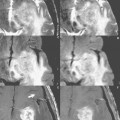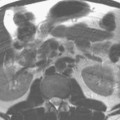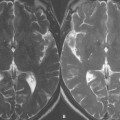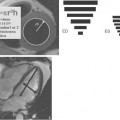73 Slice Orientation
A major strength, clinically, of MR is the ability to acquire thin slices at any angle or orientation within the body. Gradient and RF hardware make such scans possible. This difference, relative to CT, has however been largely negated due to the development of multidetector scanners.
In MR, nuclei (protons) subjected to a homogeneous, static magnetic field resonate with a frequency related to that field. At 1.5 T, the frequency for hydrogen (1H) is ~63 MHz. An RF pulse generated at this specific frequency causes all the resonating hydrogen nuclei within the homogeneous field to absorb and release energy, making spatial localization of a specific tissue impossible. However, when a magnetic field gradient is applied, the nuclei experience different magnetic field strengths and begin to resonate at different frequencies based on their position. An RF pulse can thus be tuned to a specific frequency to excite only nuclei in a desired location based on their resonant frequency. This is the concept that makes slices in any orientation possible.
Stay updated, free articles. Join our Telegram channel

Full access? Get Clinical Tree








